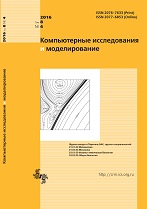|
MODELS OF ECONOMIC AND SOCIAL SYSTEMS
Languages in China provinces: quantitative estimation with incomplete data
D. V. Davydovab, A. B. Shapovalcb, A. I. Yamilovcb
a New Economic School,
47 Nakhimovskii Prospekt, 117418, Moscow, Russia
b Lomonosov Moscow State University,
1 Leninskie gory, Moscow, 119991, Russia
c NRU Higher School of Economics,
20 Myasntiskaya st., Moscow, 101000, Russia
Abstract:
This paper formulates and solves a practical problem of data recovery regarding the distribution of languages on regional level in context of China. The necessity of this recovery is related to the problem of the determination of the linguistic diversity indices, which, in turn, are used to analyze empirically and to predict sources of social and economic development as well as to indicate potential conflicts at regional level. We use Ethnologue database and China census as the initial data sources. For every language spoken in China, the data contains (a) an estimate of China residents who claim this language to be their mother tongue, and (b) indicators of the presence of such residents in China provinces. Foreach pair language/province, we aim to estimate the number of the province inhabitants that claim the language to be their mother tongue. This base problem is reduced to solving an undetermined system of algebraic equations. Given additional restriction that Ethnologue database introduces data collected at different time moments because of gaps in Ethnologue language surveys and accompanying data collection expenses, we relate those data to a single time moment, that turns the initial task to an ‘illposed’ system of algebraic equations with imprecisely determined right hand side. Therefore, we are looking for an approximate solution characterized by a minimal discrepancy of the system. Since some languages are much less distributed than the others, we minimize the weighted discrepancy, introducing weights that are inverse to the right hand side elements of the equations. This definition of discrepancy allows to recover the required variables. More than 92% of the recovered variables are robust to probabilistic modelling procedure for potential errors in initial data.
Keywords:
regional languages usage, dissimilarity indices, incomplete data identification.
Received: 27.06.2016
Revised: 28.07.2016
Accepted: 29.07.2016
Citation:
D. V. Davydov, A. B. Shapoval, A. I. Yamilov, “Languages in China provinces: quantitative estimation with incomplete data”, Computer Research and Modeling, 8:4 (2016), 707–716
Linking options:
https://www.mathnet.ru/eng/crm22 https://www.mathnet.ru/eng/crm/v8/i4/p707
|

| Statistics & downloads: |
| Abstract page: | 218 | | Full-text PDF : | 63 | | References: | 37 |
|




 Contact us:
Contact us: Terms of Use
Terms of Use
 Registration to the website
Registration to the website Logotypes
Logotypes








 Citation in format
Citation in format 